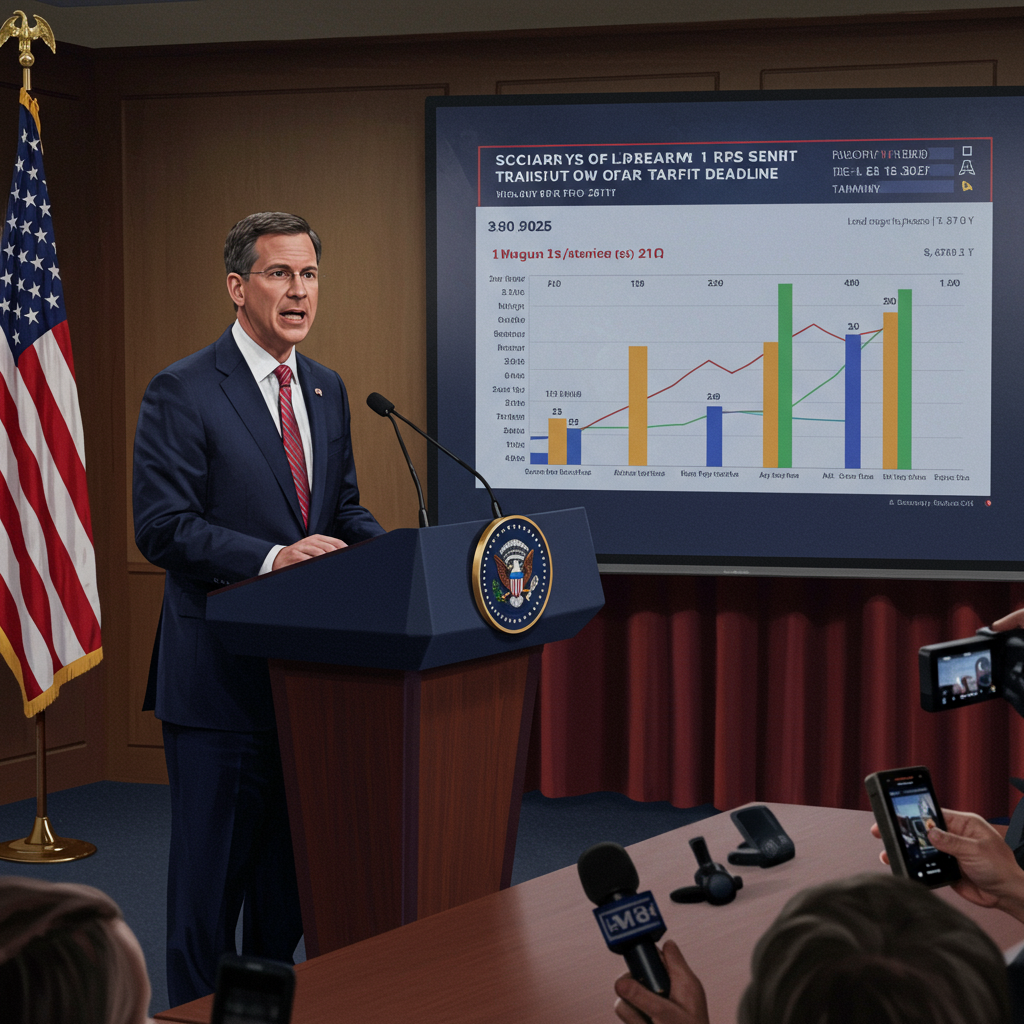The United States is poised to reimpose significant tariffs on countries failing to finalize new trade agreements. Treasury Secretary Scott Bessent recently confirmed that trading partners without completed deals will see their import duties sharply increase, reverting to the higher rates originally outlined in April. This shift is scheduled to occur on August 1st, following a period of negotiation and temporary tariff suspension aimed at spurring trade talks.
Both Secretary Bessent and President Donald Trump have issued clear warnings: countries must accelerate negotiations or face the consequence of elevated tariff rates. This policy move represents a strategic effort by the administration to leverage pressure and quickly secure favorable trade terms before the impending deadline.
The August 1st Cutoff: What It Means for Global Trade
The critical date for many U.S. trading partners is now firmly set as August 1st. According to Secretary Bessent, this date marks the point where, absent a new trade deal, the U.S. will automatically apply the steeper, country-specific tariff levels first announced on April 2nd. These initial “Liberation Day” tariffs included a baseline 10% duty across nearly all imports, with provisions for significantly higher customized rates for certain nations.
President Trump had previously granted a 90-day pause on the implementation of these higher rates, allowing countries time to renegotiate terms. That initial pause was set to expire around July 9th. However, recent statements from both the President and the Treasury Secretary have clarified that August 1st is the operational date for the tariff “boomerang.” Bessent emphasized this isn’t a new negotiation deadline, but rather a fixed date when the tariff rates will change if agreements aren’t reached. Countries, he noted, have a choice: expedite talks or return to the previously outlined, much higher tariff levels.
This shift to a firm implementation date, rather than a flexible negotiation deadline, signals a hardening of the administration’s stance. It creates immediate urgency for trading partners who have not yet concluded deals to finalize agreements quickly or prepare for potentially disruptive cost increases on goods exported to the U.S.
Driving Deals: The Strategy Behind the Tariff Pressure
The administration’s primary objective with this strategy is to compel trading partners to reach trade agreements that the White House believes will benefit the United States. Secretary Bessent indicated that President Trump intends to send formal letters to various countries, explicitly outlining the specific tariff rates they will face if a deal is not struck by August 1st.
These potential future tariffs could vary dramatically depending on the country and the status of negotiations, ranging from rates as low as 10-20% to potentially as high as 60-70% in some cases. This wide range reflects the tailored approach the administration initially designed for its April 2nd tariff structure.
While White House officials, like former trade adviser Peter Navarro, had previously expressed high optimism about rapidly securing “90 deals in 90 days,” Secretary Bessent acknowledged that many countries have not engaged in negotiations as actively as hoped. He described “foot-dragging on the other side” but also maintained that the U.S. is “close to several deals,” anticipating announcements in the coming days.
This “maximum pressure” tactic, as described by Bessent, aims to force the hand of trading partners who have delayed talks. The administration views the August 1st deadline as a necessary impetus to finalize agreements and achieve President Trump’s goals of revamping U.S. exports and reducing trade deficits.
Understanding Who Bears the Cost of Tariffs
It’s crucial to understand how these tariffs function. Tariffs are taxes on imported goods. While they are imposed by the U.S. government, they are paid by American importers—the businesses bringing the goods into the country.
These importers often absorb some of the cost but typically pass part, or sometimes all, of the increased expense onto consumers through higher prices for everyday goods ranging from cars and appliances to clothing and food. This means that while the administration intends the tariffs to pressure foreign governments, the direct financial burden is initially borne by U.S. businesses and can ultimately impact American household budgets.
The administration frames the potential tariff revenue as a significant benefit to the country, viewing it as payment for access to the U.S. market. However, economic analysis often suggests that tariffs can also harm domestic industries reliant on imported components and reduce consumer purchasing power, potentially slowing economic growth.
Progress, Resistance, and Market Reactions
Despite the challenges, the administration has reported some successes in securing agreements during the negotiation window. Deals have already been finalized with the United Kingdom and Vietnam. Additionally, a temporary truce involving reduced tariffs remains in place with China, allowing negotiations to continue. Secretary Bessent noted that the European Union, initially slow to engage, is now “making very good progress” in talks, with EU and U.S. negotiators reportedly holding intensive discussions recently.
However, the policy continues to face international pushback. Leaders from some trading partners, including Japan, have expressed reluctance to compromise easily. Furthermore, the BRICS countries (Brazil, Russia, India, China, and South Africa) are expected to issue public criticism of the U.S. tariffs, viewing them as detrimental to the global economy and potentially illegal under international trade rules.
The renewed uncertainty surrounding the tariff situation has already shown signs of impacting financial markets. Reports of President Trump mentioning the impending letters to countries led to a dip in stock futures, highlighting the sensitivity of investors to potential disruptions in global trade flows. Markets had recently seen a period of relative calm and rising values partly due to the temporary pause in significant tariff developments.
The coming days leading up to the August 1st deadline will likely see intense diplomatic activity as countries weigh the costs of failing to reach a deal against their negotiating positions. The outcome could significantly reshape global supply chains and international trade relationships.
Frequently Asked Questions
What happens if a country doesn’t make a trade deal by August 1st?
If a country does not finalize a trade agreement with the United States by August 1st, their goods imported into the U.S. will likely face significantly higher tariff rates. These rates are expected to “boomerang back” to the steeper levels initially outlined on April 2nd, which included a 10% baseline and potentially much higher customized duties depending on the specific country and product categories.
Where can I find the specific tariff rates for my country after August 1st?
President Trump indicated that the administration plans to send formal letters to countries outlining the specific tariff rates they will face if a deal is not reached. These rates are tailored country-by-country. While a central public list wasn’t explicitly mentioned in the reports, businesses and importers should monitor official U.S. government sources, such as the Treasury Department or U.S. Customs and Border Protection, for official announcements and detailed tariff schedules as the August 1st date approaches.
Should businesses importing goods from countries without a deal prepare for higher costs?
Yes, businesses importing goods from countries that do not finalize a trade deal with the U.S. by August 1st should absolutely prepare for potentially significant increases in import costs. Tariffs are paid by U.S. importers, and these higher duties will directly impact their expenses. Businesses should evaluate their supply chains, assess their exposure to the affected countries, and consider strategies to mitigate the impact, such as seeking alternative suppliers or adjusting pricing.
Conclusion
The August 1st deadline for trade deals represents a pivotal moment in U.S. trade policy. The Trump administration is applying direct pressure, threatening a return to steep tariff rates if negotiations are not successfully concluded. While some deals have been made and others are reportedly close, many countries face the prospect of significantly higher costs for accessing the American market. This strategy, framed as necessary to secure favorable terms for the U.S., carries potential economic risks and continues to generate uncertainty in global markets and among international partners. The coming weeks will reveal whether this pressure tactic results in a flurry of new agreements or a widespread imposition of elevated tariffs.


